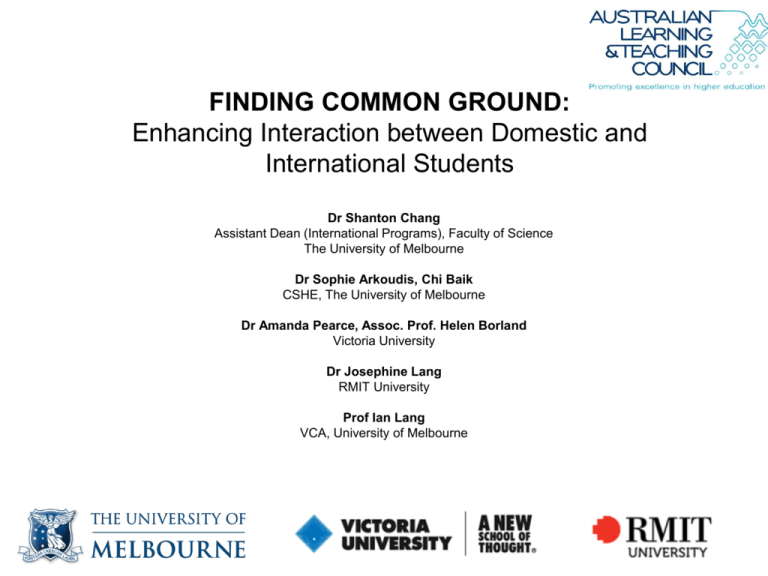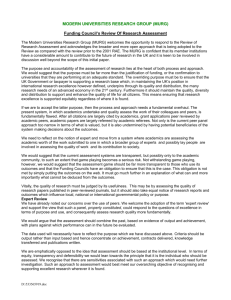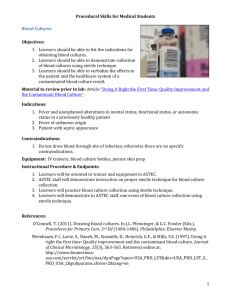See the workshop slides – VUW - Victoria University of Wellington
advertisement

FINDING COMMON GROUND: Enhancing Interaction between Domestic and International Students Dr Shanton Chang Assistant Dean (International Programs), Faculty of Science The University of Melbourne Dr Sophie Arkoudis, Chi Baik CSHE, The University of Melbourne Dr Amanda Pearce, Assoc. Prof. Helen Borland Victoria University Dr Josephine Lang RMIT University Prof Ian Lang VCA, University of Melbourne Current Situation • Currently, the work done around internationalising the curriculum in Australia tends to focus on the following themes; how to teach across cultures and international students how to include culturally inclusive curriculum; and the use of international case studies (Arkoudis, 2006; Ballard and Clanchy, 1997; Biggs, 1997, Chang, 2007). • In addition, Ladd and Ruby (1999) and Kashima and Loh (2006) provide further insights into the adjustment and acculturation needs of international students. • Additionally, work is being done on what competencies are needed by academics who teach across cultures (Sanderson, 2007) Benefits of Engagement • The Faculty of Commerce and Administration pursues and shares knowledge of business, economics and management, to develop capability and provide our stakeholders with a global perspective. Global Perspective: We play a distinctive role in connecting New Zealand to the world, through international linkages in research, learning and scholarship, and through the diversity of our staff and student body. Obstacles to Engagement • Eisenchlas and Trevaskes (2007) – People prefer to stay within familiar cultural groups – Greater numbers of students from particular regions and cultures also mean that the need for interaction across cultures is less urgent. Greater cultural understanding • Morita (2004), O'Loughlin & Arkoudis (2009) - Students who do not believe that their English language skills are at the ‘adequate level’ will select not to participate • Watkins & Biggs (1996) – Attitudes of academics pointing to lack of critical analysis skills, language problems and plagiarism • Devos (2003), Eames & Stewart (2006) – large classes with increasing diversity can be frustrating Role of Academics Hyland et al. (2008 p. 4) point out: “The attitude of the academic is crucial in determining possibilities for intercultural dialogue: it is our [the academics’] beliefs about learning and teaching that guide the way we work, that influence whether we position ‘international students’ as needing to acquire a set of skills to assimilate with the dominant pedagogical approaches or whether we position ourselves – local and international students – as needing to learn and to be open to change.” Our Propositions I • Internationalisation of higher education requires universities to cater for students from diverse linguistic and cultural backgrounds. • Learning is a cultural activity, and cultural diversity is a potential resource that is able to enhance learning. • Learning is a communication process through a set of interactions. Social interaction is seen as central to learning. Guided communicative peer interaction enables learners to explain their thoughts and engage with others in joint intellectual activity to develop their communication skills and to advance their individual capacity for critical analysis, reasoning and reflective thinking. Our Propositions II • Universities are spaces where peer interaction for learning across cultural groups may promote the development of multiple perspectives and graduate attributes desired by employers. • There is a need for a pedagogical approach that facilitates and promotes peer interaction for learning across cultural groups to capitalise on diversity, sustain social, emotional and cognitive conditions for learning and optimise learning through diverse inputs and interactions. Planning Interaction • Planning to include Peer Interaction into curriculum, assessment structures, and explicit learning opportunities… – Because believe it or not, many students don’t think they can learn anything from each other. Creating Interaction Environment • From the first week…Strategies such as social tutorials, allocating seats or tables in classes and places in group formations all helped the mixing up of the class, opening up communication among students and increasing their confidence in communicating with students beyond their own cultural groups. • Most of the academic staff that participated in the focus group interviews identified this as important in the first week of classes. Supporting Interaction • According to the findings, it is important to explain to students that: – Everyone is treated respectfully and their experience is valued – They can learn from their peers through interaction and explain how – Interaction can involve face to face or online communication – Asking question is a good thing and can assist in developing better understandings about the subject material Engaging with Subject Knowledge • The aim of the third dimension is to engage students in interaction, which may assist in developing their conceptual understandings of the subject content, through exchanging ideas, analysing material, critiquing various approaches, as they may relate to the learning outcomes of the subject. Developing Reflexive Process • During the focus group discussion, a number of academics noted the importance of reflective process as a higher level of peer interaction for learning and cognitive engagement where learners seek the knowledge base available within the community of learners, reflect on similarities and differences of understandings, and seek interaction to co-construct knowledge. Fostering Community of Learners • The ultimate goal of peer interaction across cultural groups is to enable students to develop initiatives to move across different cultural contexts and take control of their learning. • Learners collectively form a community of actively engaged learners beyond classrooms. Outcomes and Evaluations • Students who work across cultures and find these interactions interesting • Student responsibility for Group Work • Student recognition of the ways forward • Fewer – No complaints about Group Work and intercultural interactions Factors to Consider in Group Work Design The Group Work Question The Assessment Structure Recognition and Reward Lecturer Expectation Ownership and Responsibility Group Bond Providing Opportunities Clear Management Process Negotiation Conclusions • Not necessarily representative of the group’s view – It is not easy but it is possible – It requires clear institutional leadership and policy, professional development for academics and adequate resourcing – Structural issues need to be addressed – Interaction and Engagement is not an adjunct support service but central to International Education









